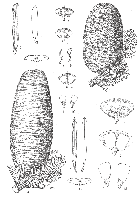
Line drawing; for full size image go to the Flora of China (Wu and Raven 1999).
Abies fargesii
Farges fir [English]; 巴山冷杉 bashan lengshan [Chinese] (Farjon 1990).
Three varieties (Farjon 1998):
The status of var. sutchuensis is unsettled; it "may be only an ecological form of Farges fir, it has leaves with more revolute margins and acute apices than the typical variety. Some authors ... are inclined to treat the varieties of A. fargesii as synonyms of the species because overlapping characters are found" (Farjon 1990). The closely related A. fanjingshanensis may also prove to be a variety of A. fargesii.
A conical tree 35-65 m tall, 150-200 cm dbh, with a cylindrical trunk. First order branches massive, short, sparse; second order branches spreading, assurgent, or pendant below. Crown narrowly pyramidal or conical. Bark smooth, grey, finely flaky on young trees, becoming grey-brown, scaly, and fissured on old trees. Branchlets smooth, shallowly grooved, slightly pubescent in the grooves; reddish brown, purplish or 'mahogany' (variable); glabrous or minutely pubescent in grooves of first year shoots; leaf scars circular. Vegetative buds ovoid to broadly obtuse, resinous, keeled, 6-8 mm long and 4-5 mm wide, slightly resinous; purple-red; bud scales triangular-ovate, yellowish-brown, persisting for several years. Leaves spirally arranged, crowded in several overlapping ranks of unequal length, the lower leaves pectinate, on coning shoots assurgent, (1-)1.5-3(-4.5) cm long × 2-3.5 mm wide, twisted at base, ligulate-linear or linear, flat or margins slightly revolute, apex emarginate or bifid, obtuse or acute on cone-bearing shoots; stomata below in two bands divided by a midrib; shining green above, whitish- or glaucous-green below; resin canals 2, medial, large. Male cones yellow with red microsporophylls, cylindrical, 13 mm long by 5 mm wide, crowded, axillary near shoot apex. Female cone bluish-purple, maturing to purplish- or reddish-brown, apex obtuse or umbilicate, ovoid-oblong or broadly cylindric, 5-9 × 3-4 cm, peduncles very short. Seed scales cuneate-flabellate, 8-12 mm long × 15-20 mm wide (at mid-cone), smooth, puberulent; upper margin rounded, entire; base pedicellate; bract hidden or slightly exserted and reflexed, bract scales: obovate-cuneate, 1-1.5 cm long. Seeds oblong, black, 5-6 × 3-3.5 mm, to 15 mm long with the black, cuneate, oblique wing (Silba 1986, Farjon 1990).
China: N Yunnan, NW Sichuan, NW Hubei, S Gansu, SW Shaanxi in the high montane to subalpine zones at 2000-4000 m altitude (Silba 1986, Farjon 1990). Hardy to Zone 6 (cold hardiness limit between -23.2°C and -17.8°C) (Bannister and Neuner 2001).
"Soils are mostly grey-brown mountain podzols. The climate is cold and moist. At its lowest elevation broad-leaved trees (e.g. Fagus engleriana, Davidia involucrata) are important but mostly it forms either pure forests or mixed coniferous forests with among other species Picea purpurea, P. asperata, P. neoveitchii, P. brachytyla, Larix potaninii, Abies chensiensis, A. recurvata, Tsuga chinensis and Taxus chinensis. Some broad-leaved trees are usually present; Betula spp., Populus spp. and many shrubs: Cotoneaster, Ribes, Spiraea, Rhododendron and Berberis are among the common genera (except in dense Picea-Abies forest)" (Farjon 1990).
The oldest reported living tree was 245 years old (crossdated) in 2016 (Liu et al. 2019, citing Zheng et al. 2016).
No data as of 2023.02.22.
No data as of 2023.02.22.
Farjon, Aljos. 1990. Pinaceae: drawings and descriptions of the genera Abies, Cedrus, Pseudolarix, Keteleeria, Nothotsuga, Tsuga, Cathaya, Pseudotsuga, Larix and Picea. Königstein: Koeltz Scientific Books.
Franchet, A. 1899. Plantarum sinensium ecloge tertia. Journal de Botanique 13:256. Available: Biodiversity Heritage Library, accessed 2020.11.26.
Liu, Jiajia, Bao Yang, and David B Lindenmayer. 2019. The oldest trees in China and where to find them. Frontiers in Ecology and the Environment 17(6): 319–22. https://doi.org/10.1002/fee.2046.
Zheng Y., Shao X., Lu F., and Li Y. 2016. February–May temperature reconstruction based on tree-ring widths of Abies fargesii from the Shennongjia area in central China. International Journal of Biometeorology 60:1175–81.
Last Modified 2023-10-31